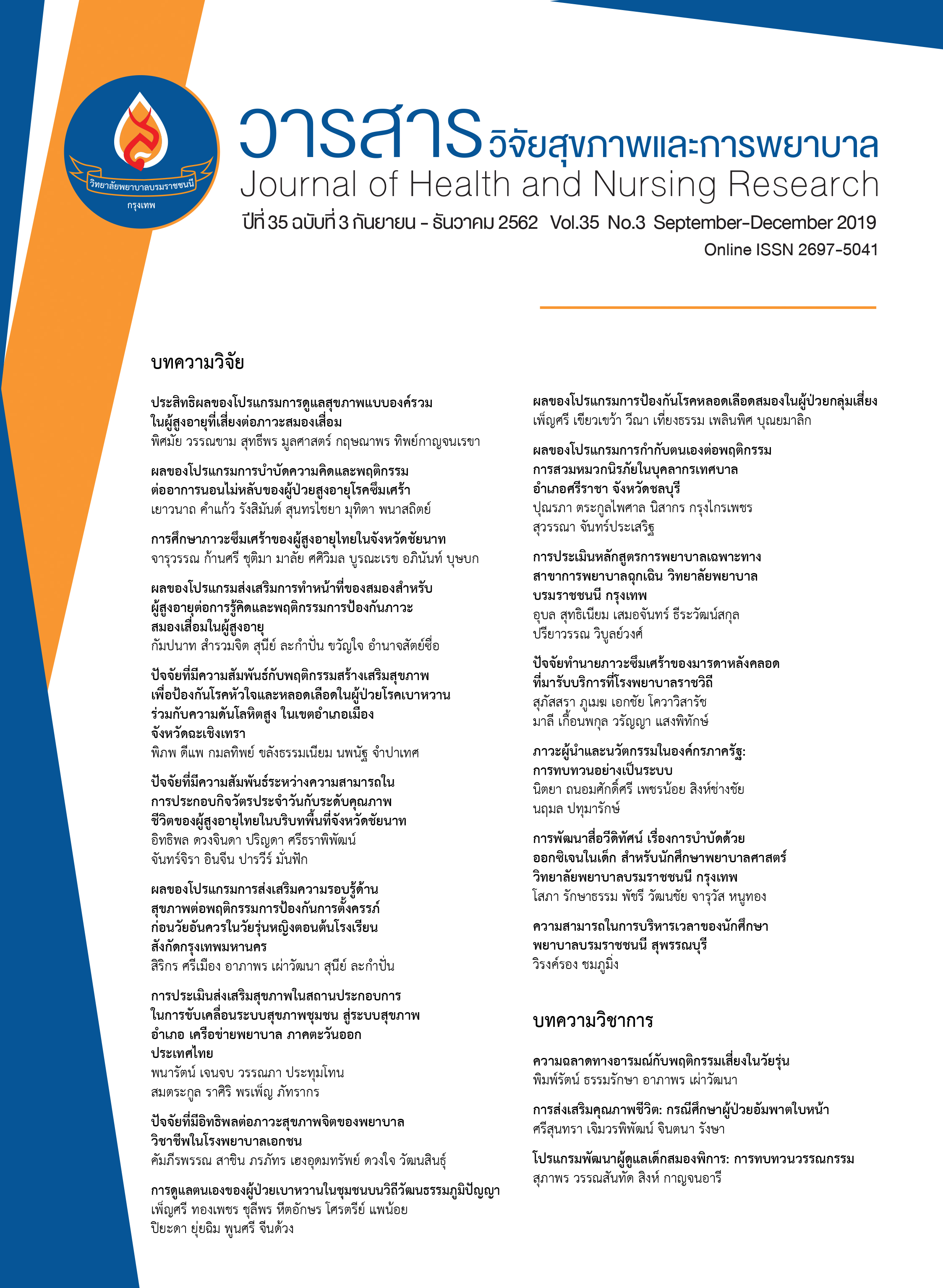ผลของโปรแกรมการป้องกันโรคหลอดเลือดสมองในผู้ป่วยกลุ่มเสี่ยง
คำสำคัญ:
ผู้ป่วยกลุ่มเสี่ยงโรคหลอดเลือดสมอง, ทฤษฎีแรงจูงใจในการป้องกันโรค, แรงสนับสนุนทางสังคมบทคัดย่อ
การวิจัยนี้เป็นการวิจัยกึ่งทดลองแบบ 2 กลุ่ม วัดก่อน-หลัง และวัดซ้ำ มีวัตถุประสงค์เพื่อศึกษาผลของโปรแกรมการป้องกันโรคหลอดเลือดสมองในผู้ป่วยกลุ่มเสี่ยง โดยการประยุกต์ใช้ทฤษฎีแรงจูงใจในการป้องกันโรคร่วมกับแนวคิดแรงสนับสนุนทางสังคม กลุ่มตัวอย่าง คือ ผู้ป่วยโรคความดันโลหิตสูงร่วมกับโรคเบาหวาน มีอายุ 50 - 70 ปี ได้รับการประเมินภาวะเสี่ยงต่อโรคหัวใจและหลอดเลือดโดยใช้ตารางสีในกลุ่มเสี่ยงปานกลาง และกลุ่มเสี่ยงสูง มารับบริการที่โรงพยาบาลส่งเสริมสุขภาพตำบล ในอำเภอหนองบัวระเหว จังหวัดชัยภูมิ จำนวน 58 คน แบ่งเป็นกลุ่มทดลองและกลุ่มเปรียบเทียบ กลุ่มละ 29 คน ระยะเวลาศึกษา 7 สัปดาห์ เก็บรวบรวมข้อมูลด้วยแบบสัมภาษณ์ในระยะก่อนการทดลอง หลังการทดลอง (สัปดาห์ที่4) และระยะติดตามผล (สัปดาห์ที่7) วิเคราะห์ข้อมูลด้วยสถิติ ค่าเฉลี่ย ร้อยละ ส่วนเบี่ยงเบนมาตรฐาน Chi-square, Independent t-test และ Repeated measure ANOVA
ผลการวิจัย พบว่ากลุ่มทดลองมีคะแนนเฉลี่ยการปฏิบัติพฤติกรรมเพื่อป้องกันโรคหลอดเลือดสมอง ในด้านการรับประทานอาหาร การใช้ยา การออกกำลังกาย และการไปพบแพทย์ตามนัด ระยะหลังการทดลองและระยะติดตามผล ดีขึ้นกว่าก่อนการทดลอง และดีกว่ากลุ่มเปรียบเทียบอย่างมีนัยสำคัญทางสถิติ (p-value < .05) ค่าเฉลี่ยความดันโลหิต และค่าเฉลี่ยระดับน้ำตาลในเลือด ลดลงกว่าก่อนการทดลอง และลดลงกว่ากลุ่มเปรียบเทียบอย่างมีนัยสำคัญทางสถิติ (p-value < .05)
จากการวิจัยครั้งนี้ สรุปได้ว่าโปรแกรมการป้องกันโรคหลอดเลือดสมองในผู้ป่วยกลุ่มเสี่ยง สามารถทำให้ผู้ป่วยมีการเปลี่ยนแปลงพฤติกรรมเพื่อป้องกันโรคหลอดเลือดสมองดีขึ้น และมีค่าความดันโลหิตและระดับน้ำตาลในเลือดลดลง ซึ่งสามารถนำไปประยุกต์ใช้กับประชากรกลุ่มโรคเรื้อรังที่มีลักษณะใกล้เคียงกันได้
Downloads
เอกสารอ้างอิง
Samcharoen Panich; 2015. (in Thai).
2. Feigin VL, Krishnamurthi RV, Parmar P, Norrving B, Mensah GA, Bennett DA, et al. GBD 2013
Stroke Panel Experts Group Update on the Global Burden of Ischemic and Hemorrhagic Stroke in
1990-2013: the GBD 2013 study. Neuroepidemiology 2015;45(3):161-76.
3. Murray CJ, Lopez AD. Alternative projections of mortality and disability by cause 1990-2020:
Global Burden of Disease Study. The Lancet Journal 1977;349(9064):1498-504.
4. Prasat Neurological Institute, Ministry of public Health. Clinical Nursing Practice Guidelines for
Stroke. Bangkok: Thana Place; 2015. (in Thai).
5. Aekplakorn W. Report of the 4th Thai People's Health Survey 2008- 2009. Nonthaburi: Health
Systems Research Institute; 2016. (in Thai).
6. Rinkaewkan P. Diabetes and Hypertension [Internet]. 2015 [cited 2017 Jun 1]. Available form:
https://hdcservice.moph.go.th/hdc/main/index_pk.php. (in Thai).
7. Thiangtham W, Lagampan S, Powwattana A. Community Capacity Building: Concept and Application.
4th ed. Bangkok: Danex Intercorporation; 2015. (in Thai).
8. Bureau of Policy and Strategy, Ministry of Public Health. Illness with major non-communicable
diseases 2017 [cited 2018 Aug 6]. Available form: https://hdcservice.moph.go.th/hdc/main/
index_pk.php (in Thai).
9. Bureau of Non Communicable Diseases, Ministry of Public Health. Risk Assessment Opportunities
Guide Ischemic heart disease and stroke (paralysis) for village health Volunteers. Nonthaburi: The
War Veterans Organization of Thailand; 2017. (in Thai).
10. Rogers RW. Cognitive and physiological processes in fear appeals and attitude change: A revised
theory of protection motivation. In: Cacioppo JT, Petty R, editors. Social psychophysiology:
A sourcebook. New York: Guilford; 1983. p. 153-176.
11. House JS. Work stress and social support. In: eBook: Document: English. Massachusetts: Addison-
Wesley; 1981. p. 141-148.
12. Cohen J. istical Power Analysis for the Behavioral Sciences. 2nd ed. New Jersey: Lawrence Erlbaum
Associates; 1988.
13. Kongvivat K, Lemsawasdikul W, Nuysri M. Effects of Preventive Behavior Developing Program for
Patient with Cerebrovascular Disease Risk at Kanchanaburi Province, Journal of Nursing and Health
care 2017;35(3):129-37. (In Thai).
14. Bureau of Non-Communicable Diseases Department of Disease Control, Ministry of Public Health
Assessment of Cardiovascular Risk in Diabetes and Hypertension patient. Bangkok: Commericial
Printer; 2015. (In Thai)
15. Bandura A. Social foundations of thought and action: A social cognitive theory. New Jersey:
Prentice-Hall; 1986.
16. Jewpattanakul Y. Strengthening Self-efficacy of the Elderly with Hypertension for Exercise: Roles
of Family Members, Journal of Nursing Science. 2012; 30(1):81-90. (in Thai).
17. American Diabetes Association. Standards of medical care in diabetes-2017. Diabetes Care
2017;40(1):25-32.
ดาวน์โหลด
เผยแพร่แล้ว
รูปแบบการอ้างอิง
ฉบับ
ประเภทบทความ
สัญญาอนุญาต
บทความที่ได้รับการตีพิมพ์ เป็นลิขสิทธิ์ของวารสารวิจัยสุขภาพและการพยาบาล (วิทยาลัยพยาบาลบรมราชชนนี กรุงเทพ) ไม่สามารถนำไปตีพิมพ์ซ้ำในวารสารฉบับอื่น


















